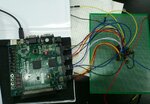sai1711
Newbie level 5
Hi All,
I got Bazinga'ed by the thing here.
After tinkering around for the past 8 days on my FPGA+ DAC to generate a Sinewave. I am still stuck.
Specs:
128 word deep ROM was used by me on VHDL
Board: Nexsys2
DAC: LTC1668, 16-bit Data In and differential signal IoutA and IoutB
code used:
UCF file :
DAC Output


I got Bazinga'ed by the thing here.
After tinkering around for the past 8 days on my FPGA+ DAC to generate a Sinewave. I am still stuck.
Specs:
128 word deep ROM was used by me on VHDL
Board: Nexsys2
DAC: LTC1668, 16-bit Data In and differential signal IoutA and IoutB
code used:
Code:
---------------ROM module------------
library ieee;
use ieee.std_logic_1164.all;
use ieee.std_logic_arith.all;
use ieee.std_logic_unsigned.all;
entity ROM is
port( Clock : in std_logic;
Reset : in std_logic;
Enable : in std_logic;
Read : in std_logic;
Address : in std_logic_vector(6 downto 0);
Data_out: out std_logic_vector(15 downto 0)
);
end ROM;
--------------------------------------------------------------
architecture Behav of ROM is
type ROM_Array is array (0 to 127)
of std_logic_vector(15 downto 0);
constant Content: ROM_Array := (
0=>"0000000000000000",
1=>"0000001111011101",
2=>"0000011110111000",
3=>"0000101110001110",
4=>"0000111101011100",
5=>"0001001100100001",
6=>"0001011011011010",
7=>"0001101010000101",
8=>"0001111000011111",
9=>"0010000110100110",
10=>"0010010100011000",
11=>"0010100001110011",
12=>"0010101110110100",
13=>"0010111011011011",
14=>"0011000111100011",
15=>"0011010011001101",
16=>"0011011110010101",
17=>"0011101000111011",
18=>"0011110010111100",
19=>"0011111100010111",
20=>"0100000101001011",
21=>"0100001101010101",
22=>"0100010100110110",
23=>"0100011011101011",
24=>"0100100001110100",
25=>"0100100111001111",
26=>"0100101011111100",
27=>"0100101111111010",
28=>"0100110011001001",
29=>"0100110101100111",
30=>"0100110111010101",
31=>"0100111000010010",
32=>"0100111000011110",
34=>"0100110111111010",
35=>"0100110110100100",
36=>"0100110100011110",
37=>"0100110001101000",
38=>"0100101110000001",
39=>"0100101001101011",
40=>"0100100100100111",
41=>"0100011110110101",
42=>"0100011000010110",
43=>"0100010001001011",
44=>"0100001001010101",
45=>"0100000000110110",
46=>"0011110111101111",
47=>"0011101110000000",
48=>"0011100011101101",
49=>"0011011000110101",
50=>"0011001101011100",
51=>"0011000001100011",
52=>"0010110101001011",
53=>"0010101000010111",
54=>"0010011011001001",
55=>"0010001101100010",
56=>"0001111111100101",
57=>"0001110001010100",
58=>"0001100010110001",
59=>"0001010011111111",
60=>"0001000101000000",
61=>"0000110101110110",
62=>"0000100110100011",
63=>"0000010111001011",
64=>"0000000111101111",
65=>"1111111000010001",
66=>"1111101000110101",
67=>"1111011001011101",
68=>"1111001010001010",
69=>"1110111011000000",
70=>"1110101100000001",
71=>"1110011101001111",
72=>"1110001110101100",
73=>"1110000000011011",
74=>"1101110010011110",
75=>"1101100100110111",
76=>"1101010111101001",
77=>"1101001010110101",
78=>"1100111110011101",
79=>"1100110010100100",
80=>"1100100111001011",
81=>"1100011100010011",
82=>"1100010010000000",
83=>"1100001000010001",
84=>"1011111111001010",
85=>"1011110110101011",
86=>"1011101110110101",
87=>"1011100111101010",
88=>"1011100001001011",
89=>"1011011011011001",
90=>"1011010110010101",
91=>"1011010001111111",
92=>"1011001110011000",
93=>"1011001011100010",
94=>"1011001001011100",
95=>"1011001000000110",
96=>"1011000111100010",
97=>"1011000111101110",
98=>"1011001000101011",
99=>"1011001010011001",
100=>"1011001100110111",
101=>"1011010000000110",
102=>"1011010100000100",
103=>"1011011000110001",
104=>"1011011110001100",
105=>"1011100100010101",
106=>"1011101011001010",
107=>"1011110010101011",
108=>"1011111010110101",
109=>"1100000011101001",
110=>"1100001101000100",
111=>"1100010111000101",
112=>"1100100001101011",
113=>"1100101100110011",
114=>"1100111000011101",
115=>"1101000100100101",
116=>"1101010001001100",
117=>"1101011110001101",
118=>"1101101011101000",
119=>"1101111001011010",
120=>"1110000111100001",
121=>"1110010101111011",
122=>"1110100100100110",
123=>"1110110011011111",
124=>"1111000010100100",
125=>"1111010001110010",
126=>"1111100001001000",
--127=>"1111110000100011",
--128=>"0000000000000000"
--63=>"0000000000000000",
OTHERS => "1111110000100011"
);
begin
process(Clock, Reset, Read, Address)
begin
if( Reset = '1' ) then
Data_out <= "ZZZZZZZZZZZZZZZZ";
elsif( Clock'event and Clock = '1' ) then
if Enable = '1' then
if( Read = '1' ) then
Data_out <= Content(conv_integer(Address));
else
Data_out <= "ZZZZZZZZZZZZZZZZ";
end if;
end if;
end if;
end process;
end Behav;
-----------------------------------------------------------
--------------------------------------------------counter module to count 4-bit address------
library ieee ;
use ieee.std_logic_1164.all;
use ieee.std_logic_unsigned.all;
----------------------------------------------------
entity counter is
port( clock: in std_logic;
rst: in std_logic;
count: in std_logic;
Q: out std_logic_vector(6 downto 0)
);
end counter;
----------------------------------------------------
architecture behv of counter is
signal Pre_Q: std_logic_vector(6 downto 0);
begin
-- behavior describe the counter
process(clock, count, rst)
begin
if rst = '1' then
Pre_Q <= "0000000";
elsif (rising_edge(clock) and rst='0') then
if count = '1' then
Pre_Q <= Pre_Q + '1';
end if;
end if;
end process;
-- concurrent assignment statement
Q <= Pre_Q;
end behv;
-------------------------------------------- clock---------------------------
library IEEE;
use IEEE.STD_LOGIC_1164.ALL;
entity clk1mHz is
Port (
clk : in STD_LOGIC;
reset : in STD_LOGIC;
clk_out: out STD_LOGIC
);
end clk1mHz;
architecture Behavioral of clk1mHz is
signal temporal: STD_LOGIC;
signal counter : integer range 0 to 26 := 0;
begin
frequency_divider: process (reset, clk) begin
if (reset = '1') then
temporal <= '0';
counter <= 0;
elsif rising_edge(clk) then
if (counter = 26) then
temporal <= NOT(temporal);
counter <= 0;
else
counter <= counter + 1;
end if;
end if;
end process;
clk_out <= temporal;
end Behavioral;
--------------------------------------------------------------------MAIN MODULE-------------------------------------------------------
library IEEE;
use IEEE.STD_LOGIC_1164.ALL;
use IEEE.NUMERIC_STD.ALL;
entity sinecounter is
port (clk,reset,resetclk,rst,En,read,count: in std_logic;
clk_out: out std_logic;
sine: out std_logic_vector(15 downto 0));
end sinecounter;
architecture Behavioral of sinecounter is
component counter is
port( clock: in std_logic;
rst: in std_logic;
count: in std_logic;
Q: out std_logic_vector(6 downto 0)
);
end component;
component clk1mHz is
Port (
clk : in STD_LOGIC;
reset : in STD_LOGIC;
clk_out: out STD_LOGIC
);
end component;
component ROM is
port( Clock : in std_logic;
Reset : in std_logic;
Enable : in std_logic;
Read : in std_logic;
Address : in std_logic_vector(6 downto 0);
Data_out: out std_logic_vector(15 downto 0)
);
end component;
signal tempo: std_logic_vector(6 downto 0);
begin
x1: counter port map( clock=>clk, count=>count, rst=>rst,Q=>tempo);
x2: clk1mHz port map ( clk=> clk, reset=>resetclk, clk_out=> clk_out);
x3: ROM port map(Clock=>clk, Reset=> reset, Enable=> En, Read=>read, Address=> tempo, Data_out=> sine);
end Behavioral;UCF file :
Code:
Net "clk" Loc ="B8";
Net "sine(0)" Loc ="J13";
Net "sine(1)" Loc="M18";
Net "sine(2)" Loc="N18";
Net "sine(3)" Loc="P18";
Net "sine(4)" Loc="G15";
Net "sine(5)" Loc="J16";
Net "sine(6)" Loc="G13";
Net "sine(7)" Loc="H16";
Net "sine(8)" Loc="M13";
Net "sine(9)" Loc="R18";
Net "sine(10)" Loc="R15";
Net "sine(11)" Loc="T17";
Net "sine(12)" Loc="L15";
Net "sine(13)" Loc="K12";
Net "sine(14)" Loc="L17";
Net "sine(15)" Loc="M15";
Net "clk_out" Loc="H15";
Net "reset" Loc="G18";
Net "resetclk" Loc="H18";
Net "rst" Loc="K18";
Net "En" Loc="K17";
Net "read" Loc="L14";
Net "count" Loc="L13";DAC Output

